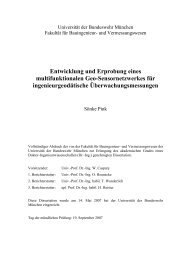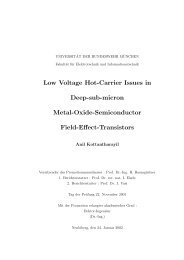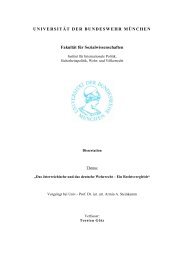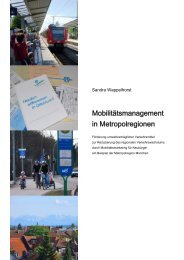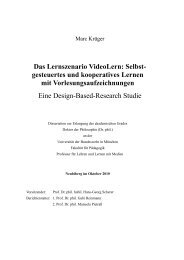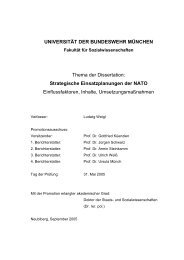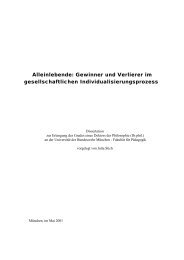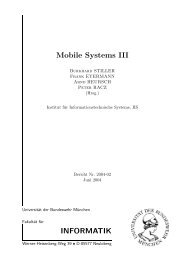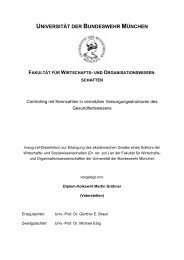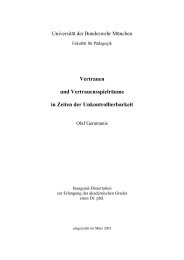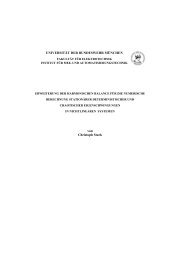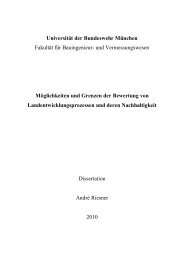Satellite Orbit and Ephemeris Determination using Inter Satellite Links
Satellite Orbit and Ephemeris Determination using Inter Satellite Links
Satellite Orbit and Ephemeris Determination using Inter Satellite Links
- No tags were found...
Create successful ePaper yourself
Turn your PDF publications into a flip-book with our unique Google optimized e-Paper software.
<strong>Inter</strong> <strong>Satellite</strong> <strong>Links</strong>References8 CONCLUSION8.1 Results <strong>and</strong> further ConsiderationsIn the frame of this Ph.D. thesis, intersatellite links have been investigated as potentialobservables for orbit determination. Introducing ISL's in an optimal way requires the states ofall satellites to be processed in one large filter. This is comparable to a geodetic networkadjustment, although the network points are orbiting instead of being fixed. Despite of the factthat in the physical world one satellite is transmitting a ranging signal while another is takingthe measurement, they are both equivalent in a mathematical sense. There is no differencebetween the measuring satellite <strong>and</strong> the target; both satellites states are improved in themeasurement update.The correlation of the satellite states due to the ISL's provides an inherent capability forbridging tracking gaps. Even if no ground station is in view, a satellite orbit can be observed<strong>and</strong> determined if it is correlated via ISL with another satellite which is observed fromground. This opens an interesting discussion: How far can the number of ground stations bereduced? In one of the simulations in chapter six a global GEO/IGSO constellation is trackedby a regional ground network of only four stations. This number can indeed be furtherreduced down to one, however the accuracy of the realtime orbit estimation decreases.Another interesting point is: what happens if the ground links are removed at all? The relativepositioning of the satellites would be ensured by the intersatellite links, but there would be aslowly increasing decoupling from the earth's rotation. In the frame of the "Autonav"capability of GPS Block IIR satellites simulations have been conducted concerning exactlythis issue. It was found that the position errors would increase up to 10 meters within 180days.It has already been mentioned that processing intersatellite links bears some operational <strong>and</strong>technological problem, i.e. where to place the antennae on the S/V bus? How to get themeasurements to a central processing facility? Is it really worth the effort? Looking at theresults from chapter six reveals that the real time estimate of the orbit is indeed better,especially in the off-radial components. However, the same accuracy can be achieved withground links by increasing the smoothing time. This reduces the advantage of ISL's over pureground links to a shortening of the required orbit arc. Nevertheless, this should not beunderestimated; after station keeping maneuvers of a satellite, the time the satellite becomesavailable again depends exactly on the length of this minimum required orbit arc.The main advantages of ISLs seem to be their observation accuracy: no troposheric delay,modest ionospheric delay. Besides orbit determination there is another application for ISL,integrity monitoring. Here, instantaneous observation accuracy cannot be so easily replacedby a longer smoothing time. In combination with onboard processing, ISLs are perfectlysuited for integrity monitoring. The measurements are taken <strong>and</strong> processed aboard thespacecraft. The integrity information is immediately available <strong>and</strong> can be broadcast to theuser. The system latency is extremely short, if any. For comparison: in a ground basedintegrity monitoring system like WAAS or EGNOS data has to be collected by groundstations, transmitted via wide area network to the central processing facility. The obtainedR. Wolf Page 189



